#The Face of Fu Manchu
Explore tagged Tumblr posts
Text
On May 30, 1966, The Face of Fu Manchu debuted in Denmark.

#the face of fu manchu#don sharp#christopher lee#crime thriller#horror thriller#horror movies#horror art#horror#cult film#movie art#art#drawing#movie history#pop art#modern art#pop surrealism#cult movies#portrait
4 notes
·
View notes
Text
youtube
Você sabia? O real motivo pelo qual a China foi de vilã para heroína nas produções hollywoodianas!
#chinese#china#007#the face of fu manchu#mao tse tung#christopher lee#sean connery#goldfinger#james bond#roger moore#you only live twice#the man with the golden gun#deng xiaoping#Akiko Wakabayashi#meg 2#jason statham#sharks#Li Bingbing#Shuya Sophia Cai#Wu Jing#Youtube
1 note
·
View note
Text
ICH, DR. FU MANCHU LEBEN...
Recently I discovered that in Germany when they released the five European Christopher Lee Fu Manchu films (known as “Fu Man Chu” in Deutschland), they recut and released their own specific versions of the films there. They are comparable to how the Japanese monster movies were changed for release in the United States, but no one in America or the series' native England seems to be aware of this. 1. THE FACE OF FU MANCHU - I, DR. FU MANCHU: 96 mins - 83 mins (PAL)/ 88 mins (NTSC)
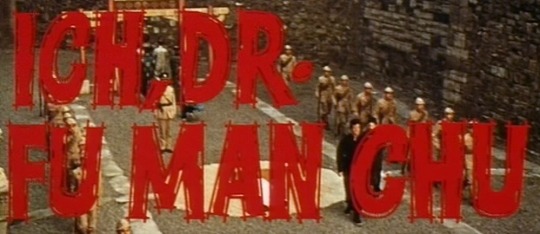
Whilst he was known as "Dr. Fu Manchu" in the Sax Rohmer books, in the Christopher Lee series, not once is he referred to as "Dr." The Germans, however, go out of their way to refer to him as only "Dr. Fu Manchu." The times "Fu Manchu" alone is used in the German dubs of the entire series can be counted on one hand. Because this was a German co-production with Great Britain, the Germans exported Joachim Fuchsberger and Karin Dor, two of the biggest stars of their "krimi" films, for the cast and they are given billing above Christopher Lee and Nigel Green! The Face of Fu Manchu begins with a moody prison beheading and the credits run over a rainstorm. I, Dr. Fu Manchu has the same video footage for its credits, but plays a jaunty, spritely tune inappropriate in the extreme, written by Gert Wilder. This tune would go on to be used for the main titles of each subsequent film as well. How the Germans felt a Chinese criminal mastermind should be represented musically: https://www.youtube.com/watch?v=GzXwjKk_nFA&ab_channel=MarcoPrati Fuschsberger and Dor dub themselves in the German dialogue, but Christopher Lee does not, which is bizarre considering Lee spoke fluent German. However, whoever did dub Lee dubs Fu Manchu for all five films.
The entire movie has been rescored (presumably by Gert Wilder, credited for the score) to replace the English score. The only time Christopher Whelan's music appears is a brief bit at the very end as Nigel Green rides off on horseback. Most of the new music amounts to stings for the end of scenes or a shock moment. Additionally, scenes that did have music in the English version go scoreless here.
The movie's opening thunderclap has been removed as well. Various scenes throughout are trimmed or cut entirely, including the action sequences. Professor Mueller (and his daughter, Maria Mueller) have been renamed Professor Merten (and Maria Merten) for some indiscernible reason.
There is a new shot and a new scene edited into the German version which seems to have been shot by the British crew. An establishing shot of the museum director's door is inserted when Nayland Smith goes to warn him about Fu Manchu.

In case you just weren’t keeping up with the movie... When the movie's action switches to Tibet, Nayland Smith's party is shown attacking and replacing the monks bringing the Black Hill Poppy seeds to Fu Manchu. Alas, there is no extra footage of Fu Manchu, though.


British colonialists beating up some Buddhist monks because they’re the heroes? Lastly, Fu Manchu's infamous warning, "the world shall hear from me again," has been replaced. As the Tibetian palace Fu is in is blown sky high, Fu seems to somehow [telepathically?!] be addressing Nayland Smith directly and tops off his threat with "I, Dr. Fu Manchu live." This phrase would be repeated for the rest of the series except the last one. There are no end titles, and this would repeat for the other four movies. 2. THE BRIDES OF FU MANCHU - THE 13 SLAVES OF DR. FU MANCHU: 94 mins - 81 mins (PAL)/ 86 mins (NTSC)
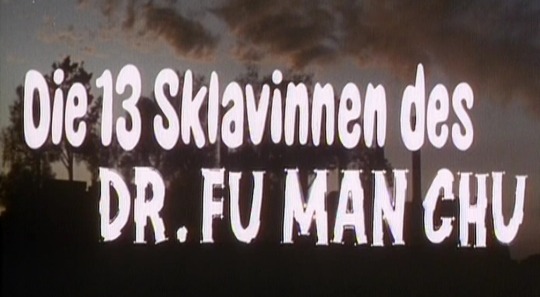
The German version opens with a recap of the end of the first movie much like the U.S. version did. However, it does not use the same footage (because the U.S. version somehow managed to have unused footage in their recap). Fu's North African stronghold is shown with establishing shots frequently, presumably with footage from another movie.

In the normal version, Fu’s stronghold is hidden under a desert mountain. Here, it’s just sitting out in the open where God and everyone can notice it. A German voiceover explains something, then the opening credits begin, again accompanied by Gert Wilder's Fu Manchu Theme. The film has once again been entirely rescored by Wilder. And as in the first movie, German actor Heinz Drache gets billing over Christopher Lee. When Jules Merlin is dragged into Fu Manchu's Egyptian-style lair, Fu welcomes him over an intercom system that is not present in the English version. Characters are again renamed for no discernible reason. Michele Merlin is renamed "Maggie." The unseen-because-he's-dead Dr. Ramchad (and his quickly-dead daughter, Shiva) has been renamed "Dr. Preston." Most outrageous of all, Douglas Wilmer's turn as Nayland Smith has been rechristened "Terrence Spencer"! Whether or not, this was done because the part had been recast is unknown. Most of Fu's references to Nayland Smith have been removed. When the film goes to England, a super appears onscreen reading "London 1924." The German version of the first movie had no such claims (and Brides takes place almost immediately following Face). A shot of Maria Mueller's home from Face has been taken and used as an establishing shot when Franz first visits Dr. Merlin in London. There are also some new shots of newspapers featuring photos of Otto Lenz. Some extra footage of a map of North Africa has been inserted when Nayland Smith/Terrence Spencer and company are trying to locate the Temple of Karnac where Fu is holed up.

Well at least they thought to show this new building blowing up in the climactic inferno as well. 3. THE VENGEANCE OF FU MANCHU - THE REVENGE OF DR. FU MANCHU: 92 mins - 80 mins (PAL)/ 85 mins (NTSC)
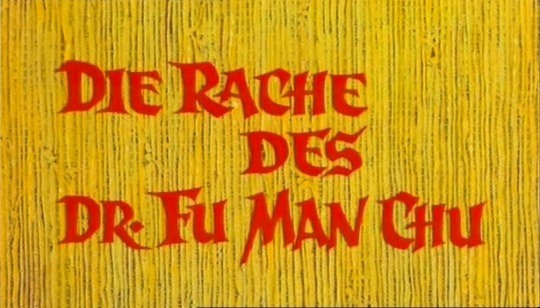
The movie starts out with a brand new title sequence, underscored with Wilder's theme music. However, the original composer Malcolm Lockyer is given credit this time around and indeed, this version has not been rescored. Christopher Lee is finally properly given top billing, as he would for the remaining two films. However, German actor Wolfgang Kieling playing the very-extremely side-character Dr. Lieberson is given second billing! Horst Frank manages to get the "and" credit. Apparently, the Germans just wanted a new credit sequence because they then proceed to use the raw footage from the movie's original credit sequence as Chinese slaves haul Fu Manchu and his daughter to their homeland province of (the fictional?) Kwang Su.

Look, ma! No supers! When the movie cuts to England, a super identifying it as "London" appears, though no year is given this time. Douglas Wilmer is back to being Nayland Smith with no explanation whatsoever. However, Horst Frank's cowboy gangster character Rudy Moss has been renamed "Ronald Moss." When Fu Manchu and his daughter speak Chinese (which they do an inordinate lot in this film), they are merely dubbed with new German dialogue. It is unknown whether the dialogue was made up or actually translated from Chinese (Tsai Chin helped Christopher Lee with his Chinese lines). Of the five movies, this one has the least changes, though a sequence of Fu Manchu explaining to Rudy/Ronald just what the hell they're doing has been removed.
4. THE BLOOD OF FU MANCHU - THE DEATH KISS OF DR. FU MANCHU: 94 mins - 78 mins (PAL)/ 82 mins (NTSC)
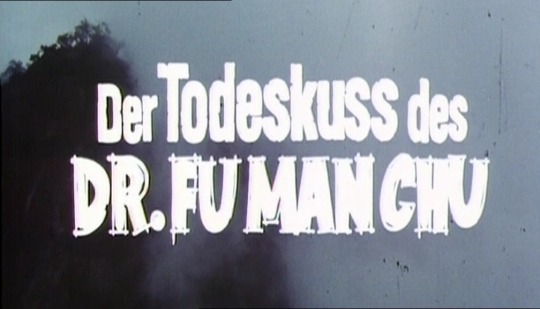
A new shot of some Amazonian waterfalls opens the movie before cutting to Fu Manchu's dacoits hauling the bevy of women to his Incan lair. There is supposedly a thunderstorm nearby (though the sky looks clear) and the sound effects are culled from audio of King Ghidorah's gravity beams in Monster Zero (no, for real)!
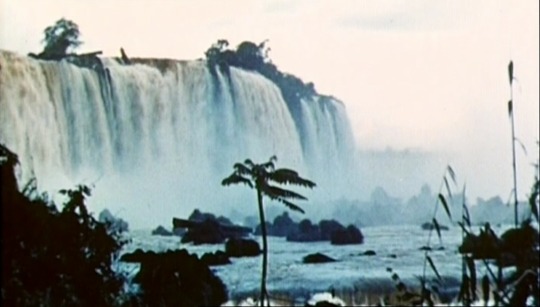
Are there even waterfalls on the Amazon?
The credits, this time, are the same credits seen in The Blood of Fu Manchu, but again have been rescored with Gert Wilden's tune. Tsai Chin does not get credit in this one (despite her being onscreen in the credit sequence!) and Jess Franco's name is cut off the screen (you just see "Regie" and no actual name).

Directed by None of Your Goddamn Business Wilden has again rescored the film with stings and cues. Only one piece of Daniel White's original score remains in the film during an early scene in a jungle. The character of Celeste has been renamed "Cheleste" for some reason.
Much of the movie's ending explosion has been cut considerably leaving things even more abrupt than the film already did. And instead of using the amazingly moody and avant garde version of "the world shall hear from me again" from the English version, here, a shot of Fu from the opening titles is superimposed over the waterfall to assure Nayland Smith that "I, Dr. Fu Manchu live."
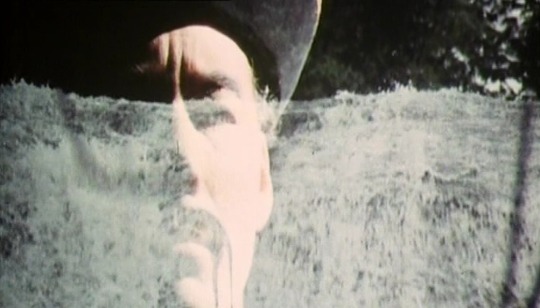
Germany, what the hell? You thought THIS was better than this???
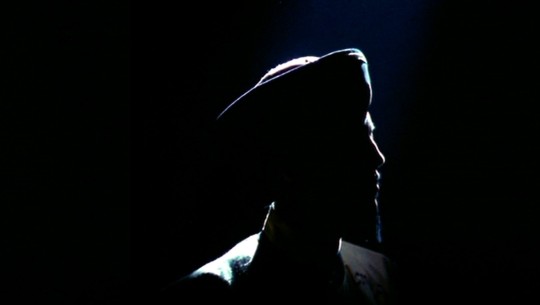
5. THE CASTLE OF FU MANCHU - THE TORTURE CHAMBER OF DR. FU MANCHU: 92 mins - 80 mins (PAL)/ 85 mins (NTSC)

The Castle of Fu Manchu has been entirely overhauled by the Germans as if they knew the film was a piece of shit and decided they were going to make it better as best they could. Constantin Films gave it a valiant go, but ultimately, the movie is still a slog. Just slightly more interesting because of the changes to the English version. The movie opens with a brand new shot of a tree limb before cutting to the insert of Fu Manchu from the opening of the previous movie as he explains his new plan.
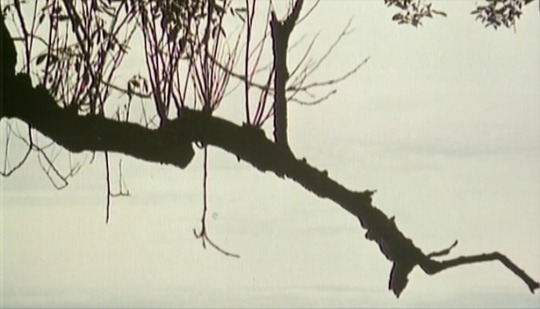
Behold, the tree limb of terror! The footage from both The Brides of Fu Manchu and A Night to Remember that make up the film's prologue has been trimmed considerably. All the footage of the ship's revelers has been taken out. Once the iceberg--er, the chunk of ice Fu has caused to appear in the Caribbean--hits the ship, the film does not cut back to the Brides footage, leaving us to believe Fu's test was a complete success, rather than the utter failure it is in the English version. Also, the Titanic footage goes from tinted blue to completely black and white and back again. The final shot of the Titan-er, ship sinking has been cropped considerably.
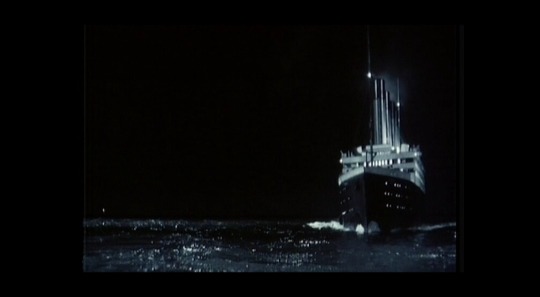
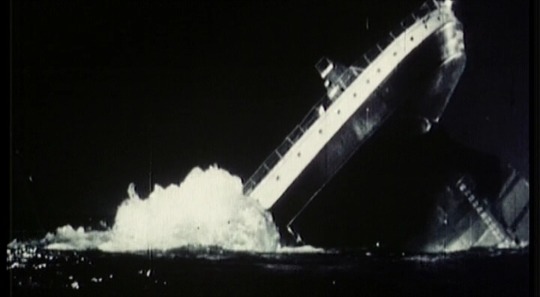
Instead of the travelogue scenes of the movie's titular castle from the English version, the movie has a brand new titles sequence. Using the footage from The Blood of Fu Manchu's credits sequence and Gert Wilden's theme song, the Germans manage to invent a far superior work (and Tsai Chin gets her credit back). Amusingly, every so often, Fu Manchu himself interrupts the credits sequence via radio broadcast announcing each time, "This is the voice of Dr. Fu Manchu!" The rest of the film has been rescored. None of the original score makes it in this version.

This time, people are not the only ones being renamed. The castle of Fu Manchu becomes a "palace." Honestly, "The Palace of Fu Manchu" does sound better and more exotic. The ailing Burt Young look-alike Dr. Heracles now becomes Dr. Henderson.
Much like the other films, new foley sounds abound. When Lin Tang follows Lisa across Istanbul to meet Omar Pasha (named for a real Ottoman field marshal), Muslim chanting can be heard in the distance.
There are two brief new scenes not in the English version, both made up of stock footage. Firstly, a scene of Lin Tang walking through the Incan prisoner cells from The Blood of Fu Manchu has been inserted for no particular reason, unless to justify the movie's new title. Another new scene uses shots from elsewhere in the film to feature Fu Manchu condemning Lisa to his torture chamber. She does not take it very well.

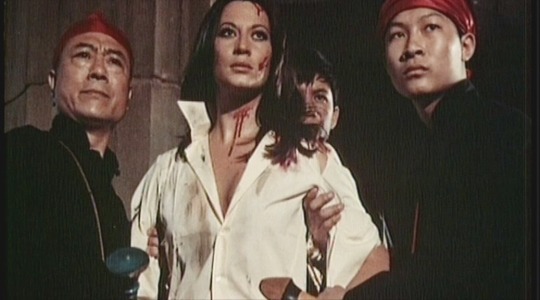
Pretty ballsy, Germany. The lame-ass explosion taken from what looks like a black and white silent film when Fu's dacoits attempt to assassinate Nayland Smith with a grenade has been replaced by an almost-as-lame still image of smoke from an explosion.
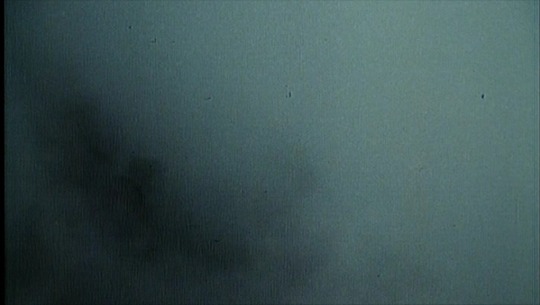
Is this really better? The end of the movie drops the bombshell that Lisa is actually Omar Pasha's daughter. She calls out "Mein vater!" before ditching Nayland Smith and Dr. Heracles/Henderson. In the English version, it's heavily implied that Pasha and Lisa are lovers! The Germans obviously took one look at this film's weak-ass "the world shall hear from me again" and wisely replaced it with the much better one from The Vengeance of Fu Manchu despite the fact Fu never wears a feather in this film. For the first time in German, Fu actually does say the phrase "the world shall hear from me again" instead of the "I, Dr. Fu Manchu live" from the prior four films.
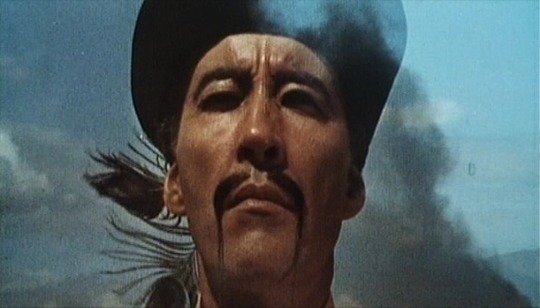
Thanks, guys. This is a lot better. Is The Torture Chamber of Dr. Fu Manchu better than The Castle of Fu Manchu? Honestly, for all its numerous changes, it's about the same quality. No better, no worse, just an interesting variant. At least it's over about five minutes quicker. The German version is certainly better, though, than the awful American version utilized for Mystery Science Theater 3000 that looked like amateurs made the film. The German versions have been released onto DVD in Germany. There is The Dr. Fu Manchu Collection and The Complete Collection of Dr. Fu Manchu. Despite the wildly different packaging, they appear to be the same disc contents and should be easily available to anyone trying to track them down (I got my set from Amazon UK).
#Fu Manchu#Christopher Lee#German#The Face of Fu Manchu#The Brides of Fu Manchu#The Vengeance of Fu Manchu#The Blood of Fu Manchu#The Castle of Fu Manchu#Ich Dr Fu Manchu#Die 13 Sklavinnen des Dr Fu Manchu#Die Rache des Dr Fu Manchu#Der Todeskuss des Dr Fu Manchu#Die Folterkammer des Dr Fu Manchu#Tsai Chin#Nigel Green#Lin Tang#Nayland Smith#Douglas Wilmer#Joachim Fuchsberger#Karin Dor#Rosalba Neri#Sara Bay#Horst Frank
1 note
·
View note
Text

#mustache#bodybuilder#hairy chest#hot guy#sexy male face#muscles#bearded hunk#bearded#muscular#hairy#masculine#sexy stud#fu manchu#horseshoe#latino
2 notes
·
View notes
Text
Klingons & Racialisation - the Long Post
This post is an overview of the racial coding of the Klingons from their first appearance to the present day, illustrated by quotes from Trek writers, actors and crew members taken from the Memory Alpha article Depicting Klingons, with my own interjected summaries and explanations. It is by no means comprehensive (I likely missed some stuff), and does not offer critical analysis of the quotes provided, but nonetheless is intended to demonstrate irreproachably the open fact that Klingons have always been intentionally written and designed as non-white -- something that fandom consistently fails to take into account when perpetuating racist stereotypes and reiterating racist canon content. I recommend reading the whole article for a more in-depth understanding of the subject, as well as seeking out the existing writing of fans of colour. This post is primarily for reference purposes so I've tried to limit my own analysis and opinions, but I do post those in my Klingon tag as well as more general headcanons and worldbuilding and I'm happy to answer any (good faith) questions this post may raise.
As always, if I have overstepped in any way as a white fan in making this post, I am grateful to be informed and will make any required changes.
Content warning for outdated and offensive language under the cut.
The Original Series
"There is some suggestion that the Klingons represent a Cold Warrior's view of China in the 1960s – swarthy, brutally repressive." (Star Trek Magazine issue 153, p. 66) "And I think he was basing a lot of it on the kind of attitude of the Japanese in World War II...." ("Errand of Mercy" Starfleet Access, TOS Season 1 Blu-ray) The script of "Errand of Mercy" introduces the Klingon look by saying, "We see the Klingons are Orientals," "Spray my hair black, give me a kind of swamp creature green olivey mud reptilian make-up, and we'll borrow some stuff from Fu Manchu, and put a long moustache and eyebrows on me." ("The Sword of Colicos", Star Trek: Deep Space Nine - The Official Poster Magazine, No. 8) "I think the makeup was called 'Mexican #1 or #2.' That was the name of the original makeup foundation – they actually had kind of racist names at the time, like 'Negro #1' and 'Mexican #2' – which was the basis for the original Star Trek makeups." (Star Trek Magazine issue 172, p. 59) "In the original series, all they wore was a dark face and their black hair," Michael Westmore observed. ("Michael Westmore's Aliens: Season Two", DS9 Season 2 DVD special features) The Klingons' appearance changed within the original Star Trek series; although dark makeup and heavy eyebrows were the norm, the Klingons of "The Trouble with Tribbles" were much lighter-skinned and more Human-like in appearance.... He noticed that they are not only less like Mongol warriors by having less of a swarthy appearance but also by being slightly not as fierce... ("The Trouble with Tribbles" Starfleet Access, TOS Season 2 Blu-ray) "...they were meant to represent the Communist foes of the United States specifically during the Vietnam War, which was being controversially fought at that time. (Star Trek: The Original Series 365, p. 222) "...let us never set up a situation whereby those adversaries of ours [Klingons] give any indication of ever being anything but highly aggressive and self-seeking opponents." (These Are the Voyages: TOS Season Three)
Here it is explicitly stated that the Klingons were based on various Asian cultures, with the USSR also being mentioned heavily in the article. This influence and the use of "yellowface" is covered more comprehensively in this youtube video Klingons & The History Of Racial Coding. However, the video has some notable gaps which I hope to cover in this post.
Post-TOS (movies)
The Star Trek III portrayal of Klingons took inspiration from Japanese history. "Harve [Bennett] had the notion that the Klingons were like Samurai warriors," explained linguist Marc Okrand. (Star Trek: Communicator issue 114, p. 27) Robert Fletcher agreed with Bennett, later saying of the Klingons, "I always liked to think of them as authoritarian, almost feudal, like Japan had been." (The Making of the Trek Films, UK 3rd ed., p. 52) Regarding the make-up, Michael Westmore observed, "Until now, Klingons were brown. Some had a bony ridge running down the middle of their foreheads, long black wigs and facial hair." (Star Trek: The Next Generation Makeup FX Journal, p. 28) "I thought it was an ideal way for us to have our closure too, because the Klingons for us have always been the Communist Block, the Evil Empire. It just made sense to do that story." (The Making of the Trek Films, UK 3rd ed., p. 100) "Gene was really bothered by the Klingons in VI [....] [They] were, in his words, 'too civilized, too decent, too much of the good guys in the story.' [....] [The Klingon detente] was not the way Gene would have handled it. He would have reversed it, he would have had the Klingons being the ones who couldn't handle the peace, with the Federation saying, 'Come on, let's try and work this out.'" (Star Trek Movie Memories, hardback ed., p. 289) "The story never explored the Klingon culture the way I'd hoped it would [....] I was hoping for greater insight into the Klingons." (I Am Spock) Nimoy hoped, in specific, that the movie would provide some important insight into why the Klingons had "always been so angry, such nasty, vicious murderers." Nimoy wanted the insightful knowledge to be an intellectually transformational force, changing the thinking of Kirk and the audience. (Star Trek Movie Memories, hardback ed., pp. 287-288) In an interview in the DS9 Season 7 DVD, Robert O'Reilly observed that a long-running joke among actors who have played Klingons is that they do not want to appear in the Star Trek films as, he believes, the only purpose of a Klingon in one of the films was to be killed off.
Although these last three quotes may not seem relevant, I believe they highlight an important facet of the racialisation of the Klingons. It reads as though Gene Roddenberry was against depicting the Klingons in a more sympathetic light than the Federation, and considering that the Klingons are intended to be non-white, refusing to give depth or motive to their anger in favour of keeping them "nasty, vicious murderers" comes across as fairly racist, especially when these kind of reductive and harmful stereotypes could've been challenged as Nimoy suggests. The treatment of Klingons as disposable villains is also concerning in this context.
The Next Generation
African-American actors were often cast as Klingons in TNG and subsequent Star Trek productions. This practice wasn't racially motivated but was instead carried out because it lessened makeup time, as the performers already had a brown complexion without having to have their skin painted that color. (Stardate Revisited: The Origin of Star Trek: TNG, Part 2: Launch, TNG Season 1 Blu-ray) Tony Todd, who portrayed the recurring Klingon character Kurn, stated, "I don't look at the Klingons necessarily as African-Americans, but it's about tapping into something–they're certainly an alienated people, so maybe that's why African-American actors can identify with those characters. But that doesn't mean it's exclusive to them." (Star Trek: Communicator issue 116, p. 54) Michael Westmore actually changed the Klingon facial design in numerous ways, though. He stated, "I added a Shakespearean style of facial hair and a forehead bone structure based on dinosaur vertebrae and I was able to modify motion picture Klingons for television." (Star Trek: Aliens & Artifacts, p. 59) In "A Matter Of Honor", the Klingons were intended to be used to shed some light on a common social problem prevalent at the time of the episode's making. This was, namely, what it was like to be the only person of either white or black skin coloration while surrounded by people of the other color. The Klingons were selected to illustrate this theme as a spin on the usual arrangement of a predominantly Human crew serving aboard the Enterprise-D alongside Worf. (Captains' Logs: The Unauthorized Complete Trek Voyages, p. 176) Two historical societies, the Samurai and Vikings, served as other inspirations, Moore perceiving about Klingon culture, "There was the calm, elegant reserve associated with the Samurai but there was the 'party-down' like the Vikings." (Star Trek: Communicator issue 114, p. 58) "I stopped thinking of the Klingons as the Cold War adversary," he explained. "I didn't think it fit [....] The place where the Russians were when I was doing the Klingon shows just wasn't as relevant any more." (Star Trek: The Magazine Volume 1, Issue 19, pp. 64-65) "The Klingons are not evil, tyrannical pirates bent only on pillage and plunder. They have a strict, almost unyielding code of ethics and honor and take their responsibilities as rulers seriously." Following a description of the Klingon homeworld, the memo continued by saying, "Klingon society could most closely be compared to that of Sparta or feudal Japan." ("Sins of the Father" audio commentary, TNG Season 3 Blu-ray) Having recently seen the film Malcolm X, he imagined the Klingons in the "Birthright" duology as metaphors for black people. (Captains' Logs: The Unauthorized Complete Trek Voyages, p. 274; Star Trek: Communicator issue 105, p. 16) "There's a certain way you have to carry yourself. You have to really be able to project the violence and the anger [....] All you have to do is think of the Spartans. They say, 'They'd rather have you come home dead on your shield than come home a coward.' [18]
This is where I feel the video essay previously mentioned falls short -- in the next gen era, Klingons are now explicitly black-coded. While some Asian cultural influences are still cited, they learn more towards the historical and are intermixed with other historical European influences (Spartans, Vikings, Shakespeare) rather than being fueled by contemporary prejudices towards the political enemies of the US as they were in the TOS era.
Deep Space Nine
Fields also generally based the Klingon group on American Western prototypes from the film The Magnificent Seven or, to a lesser extent, Japanese prototypes from The Magnificent Seven's movie source material, Seven Samurai. (Star Trek: Deep Space Nine Companion (pp. 131-132)) "So, the hair [...] was permed. So, it had more of a curl instead of the straight type look, and by perming it, they were able to kind of give them larger, bigger hair, so it was more like a mane." ("Michael Westmore's Aliens: Season Two", DS9 Season 2 DVD special features) "I don't know how you could equate Klingons with what's going on in the world today," he admitted. "I think the intention was to make them like samurai. That hairdo they gave them is very much a samurai hairdo. A lot of the fight sequences, the moves with the bat'telh, are very much taken out of the Asian martial arts [....] It's very romantic you know, these three old guys, the Klingon over-the-hill gang." (The Official Star Trek: Deep Space Nine Magazine issue 15, pp. 17-18) "It was different for them to get into this makeup, because [...] [the makeup was more elaborate and] the beards were bigger, and they were greyer, and they had curls to them, and the moustaches, they had the Fu Manchu look to them. So, they weren't used to sitting that long to be a Klingon." ("Michael Westmore's Aliens: Season Two", DS9 Season 2 DVD special features) For recreating some old-style Klingons in "Trials and Tribble-ations", the Klingon-playing actors had to be made up with the same swarthy, shiny brown makeup as used in the original series. (The Magic of Tribbles: The Making of Trials and Tribble-ations) ...he had them unite in song, thinking this was "just the kind of thing that Klingons do" because they are, in his opinion, similar to Vikings. (Star Trek: Deep Space Nine Companion (p. 449)) "I always saw the Klingons as a combination of Japanese Samurai who haven't had their morning coffee (or tea!) and African Zulu warriors." [25]
In DS9 the only inspirations cited seem to be historical, once again leaning towards feudal Japan and the Vikings. Interestingly although the Klingons here are predominantly dark-skinned, I don't think that J.G. Hertzler, who is white, had his skin significantly darkened to play Martok (at least, not compared to the obvious brown makeup worn by other white actors playing Klingons). Having a white actor play a Klingon without dark makeup could've set a precedent decreasing the use of such practices later on, but no one seems to have picked up on it.
Enterprise
The Klingons of ENT: "Sleeping Dogs" were based on the crew of the Russian submarine Kursk. "For me," said Dekker, "the point was to acknowledge the Klingons as 'people' – to find them in a clear position of distress [....] The idea to 'humanize' their plight was mine, and it wasn't anything I thought about as far as canon. It just seemed right." (Star Trek: The Official Starships Collection, issue 41, pp. 10-12) In the final draft script of "Affliction", the altered Klingons were initially referred to as "fierce-looking aliens" and were further described thus; "The aliens have a swarthy complexion, and dark facial hair... they could easily be mistaken for Humans. We'll eventually learn these are Klinqons... but their cranial ridges have disappeared."
At this point in time it seems the Klingons had essentially done a 180 from one-dimensional villains to sympathetic fan favourites, while still retaining the skin-darkening aspect of their makeup and "barbaric" characterisation. Although this is not mentioned in the article's section on the Abrams films, the images provided do demonstrate a level of skin darkening for the Klingons' brief appearance in Into Darkness.
The final section of the article is incomplete, meaning I don't have a lot of information for Discovery's redesign of the Klingons. The sources I can find cite ancient civilisations such as the Byzantines as well as Islamic architecture as inspiration for the set design, with a baroque influence on the costumes. I have heard rumours that the crew of Discovery have cited North African cultures as their inspiration for the Klingons but I can't currently find a source for this. Despite the lack of direct quotes, it's visibly clear that the Klingon makeup is still darkening the skin of white actors, although this time also to non-human blue and purple colours, as well as altering certain features in a racialised way. To elaborate: Mary Chieffo, who plays L'Rell on Discovery, is white and has a very thin nose and small lips, but in costume these are broadened in a way that seems imitative of African ethnic features.
As of the making of this post (early August 2023) I haven't seen any of Strange New Worlds, but from some cursory research its latest episode (Subspace Rhapsody) seems to have put a white actor (Bruce Horak) in brown makeup to play a Klingon. I am deeply disappointed that on a television set in 2023 people can still be darkening an actors skin like this without questioning the racial implications of what they're doing.
Thank you for reading to the end of this post. Please feel free to link to it if you found it useful enough to cite in another context. I would like to reiterate that I am white and while this is an issue I care deeply about it is not one I have an emic understanding of, and if anything I've said here is inappropriate I would be very grateful to be made aware.
#ive tried to make this like. really formal to cover the fact that im fuckin Ragin at snw for doing literal fucking brownface in 2023#next up top ten things fans should Fucking Reconsider saying about klingon characters#anyway#i feel like as a white trekkie who's big into klingons there's this insane blindspot when it comes to The Racism#that ive only ever seen fans of colour talk about#so if i have one goal for this post its to try and reduce that blindspot a bit and give people something concrete to point to#when some fuckwits in their notes acting as tho ~theyre aliens so it cant be racist~#tlhIngan#ghItlhpu'wIj
232 notes
·
View notes
Text
Analyzing Skwisgaar's Nightmare in "Dethlessons"
requested by @claudia-nomusaabara
hi. anyone else obsessed with grub toki?
let's get the context of this scene out of the way. toki has started going to get guitar lessons from dimneld selftcark, and nathan, pickles, and murderface have lied to skwisgaar and told him that those lessons have helped him improve. and we see that skwisgaar is not pleased with this situation.
the dream goes like this:
skwisgaar opens up his bedroom window from a deformed version of mordhaus. the whole scene is very post-apocalyptic and almost eldritch. looking at it visually, this is a world ruled by guitars. we see skwisgaar's explorer, toki's flying v, and even what appears to be dimneld's les paul.
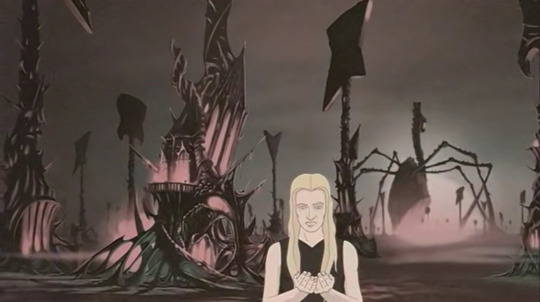
there is a second skwisgaar. he is holding a deflated husk of toki's head. that thing is barely holding onto life, it is spurting out liquids. skwisgaar has a very neutral expression when looking at it. meanwhile, the original skwisgaar is trying to make a call while the other skwisgaar buries the toki head.
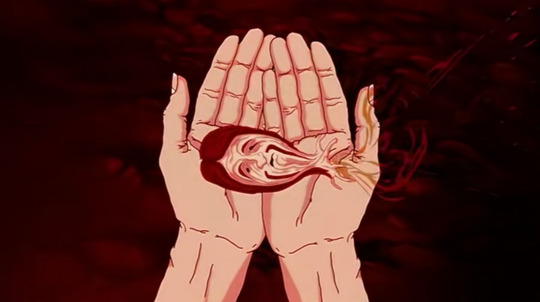
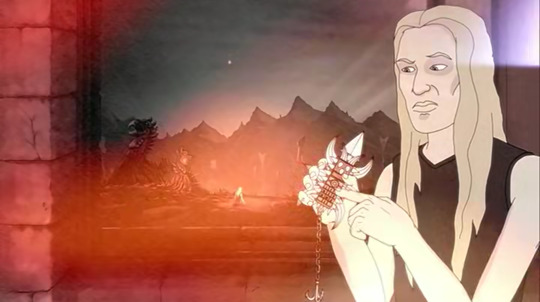
the other skwisgaar sees the dethklok helicopter fly overhead, and it fades to a shot of skwisgaar performing in front of a crowd--he is by himself, the rest of dethklok are not with him and he is not in his corpse paint. though the crowd is cheering for him, he can't play. his hands have become deformed stumps, and his guitar is made of flesh, a large gnawing mouth on the body.

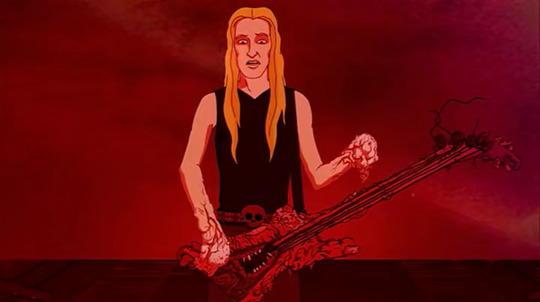
we flash back to the original skwisgaar in the deformed mordhaus. he's still trying desperately make his call, but his hands have also become deformed. the skwisgaar that was burying the toki head is shocked. the toki head is no longer deflated and pathetic. it has started to grow out from the ground, taking on a more distinct floral shape. whereas before it looked like it was close to death, now it is fighting for life. (below/right screenshot was edited for less brightness/exposure).
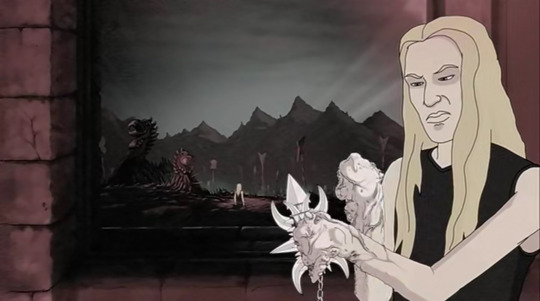
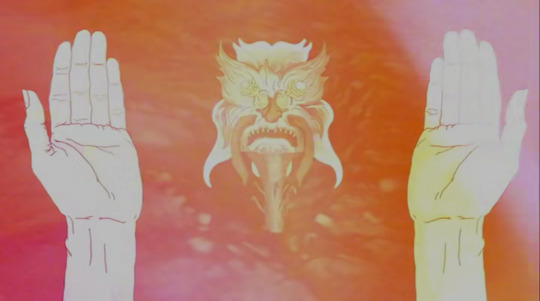
the toki flower starts gnawing at the air, similar to the fleshy guitar that it flashes to briefly. then we change scenes to skwisgaar using a urinal in a public restroom. while pissing, he notices in the urinal an insect-like creature that has toki's signature fu manchu mustache. it is also pathetic and whimpering.
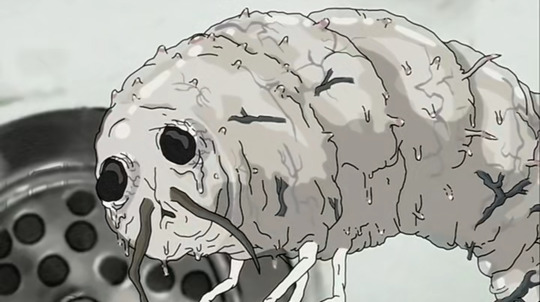
this is what sends skwisgaar falling down into the abyss. scene change. the two skwisgaars see a massive toki emerge. he is hulking, monstrous, his arms are two explorer guitars with mouths on the end.
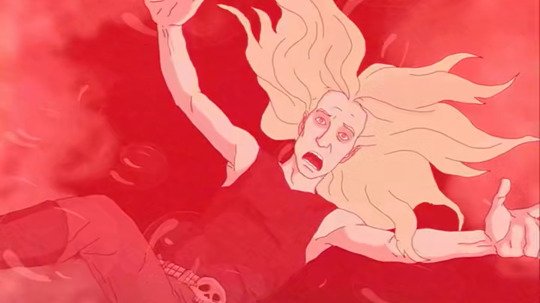
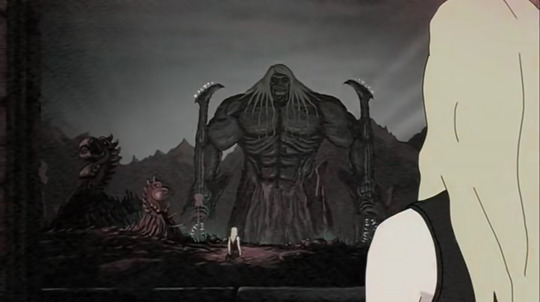
the toki flower does...THIS???? the hulking toki makes a similar face, his eyes have also become mouths.
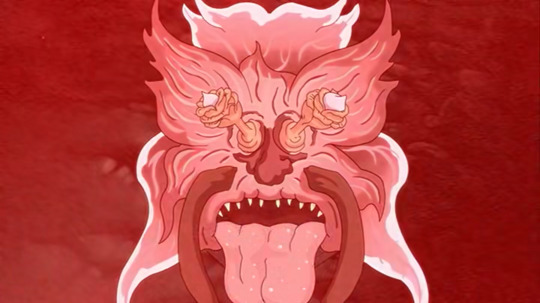
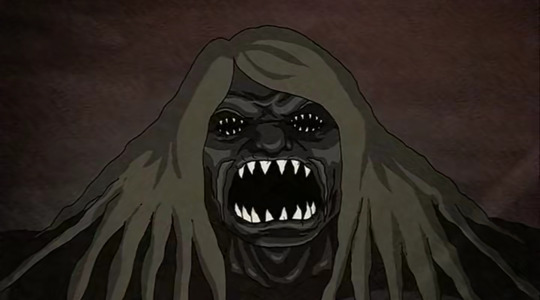
skwisgaar wakes up.
so, here are some themes i notice pretty quickly: 1) toki being seen as week/below skwisgaar, 2) growth, 3) hands, 4) mouths. taking this step by step:
1) skwisgaar sees himself as living in a world ruled by music. everything else is second to that. guitar rules his over his entire life. toki was someone he tried to nurture. we know from DSR that skwisgaar was the one who invited him into the band despite the fact that, for all intents and purposes, toki failed his audition--skwisgaar just saw something in him that no one else did. we also see from earlier in this episode that skwisgaar has no problem "teaching" toki, he just has a very particular way of doing it; an unhelpful way. he recognizes toki's talent, but he always will see him as being beneath him--or at least he always wants him beneath him, offering to help him grow because he knows he has the capacity and the raw talent for it, but refusing to help him in a way that would allow him to surpass him. skwisgaar is burying the husk of toki's head because it is nearly drained. there's not much left for him to give. but the other skwisgaar is trying desperately to call him, but he can't (or won't) hear these pleas. the other skwisgaar represents his knowledge of toki's ability. he's trying to warn his other self not to be dismissive of toki.
i also see the grub toki as representing toki when he first met skwisgaar. just a lost, pathetic kid who desperately needed anything to help him out. skwisgaar obviously saw something in him, but he was still so far beneath him. going from grub toki to skwisgaar falling down an abyss represents, in part, to me, the spiral that inviting this kid over would lead him down.
2) the fact that forms of toki grow not once, but twice. we have the head husk growing into the flower, representing that, even when skwisgaar seemingly gives up on toki, that's not going to stop him from growing. you could even argue that skwisgaar is holding him back from growing, and i do agree with that to an extent (skwisgaar is too afraid of failure and no longer being number one that he doesn't think of how he's hurting toki, he's just one-track mind).
"oh but mj you said pathetic forms of toki grow twice in this dream? only the toki head husk grows." you sweet summer child. you babe wrapped in swaddling cloth. what do you think the grub toki is? and i don't mean literally, because i don't know what the fuck cursed larva specimen he is. but remember what i said? the initial shot of the toki flower flashes to the deformed guitar before flashing to grub toki. they're all connected!!!! we also see grub toki right before hulking toki emerges, and hulking toki has the deformed guitar as hands. it is my correct theory that grub toki was a thirtsy little flower that was watered by skwisgaar's pee and became hulking toki. the flashes between flower toki and hulking toki with similar faces also reinforces the idea that they're similar creatures that skwisgaar had given up on but had used skwisgaar's degradation and dismissal to their advantage and to surpass him.
3) the biggest threat skwisgaar could have, outside of toki surpassing him, is something happening to his hands. you can't fuck up a guitarist's hands, that's kind of their whole thing. I WROTE A FIC ABOUT IT. skwisgaar's hands get fucked up here in two different scenarios: when actually playing, which makes sense as his biggest fear, but also when he's trying to contact himself about toki. he's not just scared about toki surpassing him. he's very much aware about how his own insecurities about the scenario could paralyze him from playing. he gets in his own head a lot (most notably during his fight with toki in "bookklok"), and so if he feels like he's not number one anymore, he's scared that he can't play at all--or if he can, it's not worth it because he's not the best. and then, his deformed hands also keep him from calling himself. he struggles with communication as it is, but the insecurity is wearing on him so much to make his terrible communication skills even worse. the hulking toki also has his hands replaced with explorers. NOT flying v's. while skwisgaar's hands and playing is at risk of being destroyed forever, according to his greatest fear, toki's will only be greatly improved, and having the explorers is reminiscent of the symbolic role of lead guitarist. toki doesn't need his flying v anymore--he has skwisgaar's guitar, he has his role in the band.
4) though so many of these cursed objects have mouths, this dream is completely dialogue-less. once again, we see that skwisgaar is struggling to actually speak to toki. and toki isn't interested in talking to him either. hell, toki doesn't even see what skwisgaar is struggling with, what he's so afraid of. husk toki doesn't have eyes. flower toki's eyes are replaced with flower buds. grub toki's eyes are black and empty. and hulking toki's eyes are replaced with mouths. toki does not want to look at skwisgaar, does not want to see in him what he also has so much of--insecurity about his guitar playing, just reflected back at him.
and the mouths. they just gnaw at nothing. they're trying to devour skwisgaar. hulking toki's eyes are mouths because he isn't interested in seeing him--he only wants to consume him, to rip him apart and take everything away from him.
TL;DR--skwisgaar's biggest fear is toki becoming better at him than guitar. he's regretting inviting him in, and all he can imagine is toki taking his role away from him, chewing him up, spitting him out, leaving him with nothing. but there's also a part of him that knows that this was partially his fault--that he always knew that toki had this potential. he blames himself, partially, but he's so insecure now and terrified of toki's potential that all he can do is imagine toki as delighting in this scenario.
toki was just a little larva when skwisgaar invited him into the band. he gave him just enough to help him grow, but he also did it in such a dismissive way. but the larva still grew, and it's a butterfly that's going to rip skwisgaar's hands clean off.
#dichromaticdyke.exe#Metalocalypse#Skwisgaar Skwigelf#Toki Wartooth#written in a fit of divine madness#i channeled some BDG energy for this one#grubki#<- for you my server friends
82 notes
·
View notes
Text
Misconceptions:

You know it occurs to me that in today's world Boris Karloff would as a quarter Indian biracial actor probably be called woke casting? Not that this is a widely known fact. But in regards to him playing such roles as Jekyll and Hyde, Mycroft Holmes and nearly Cagliostro and Bluebeard. Don't believe me? Look at the reaction to actor Rupert Laight as Isaac Newton in Dr Who. Even in some more left-wing circles. It's coming to something when an ethnic actor gets less grief for such casting in the early twentieth century than one in the modern age?
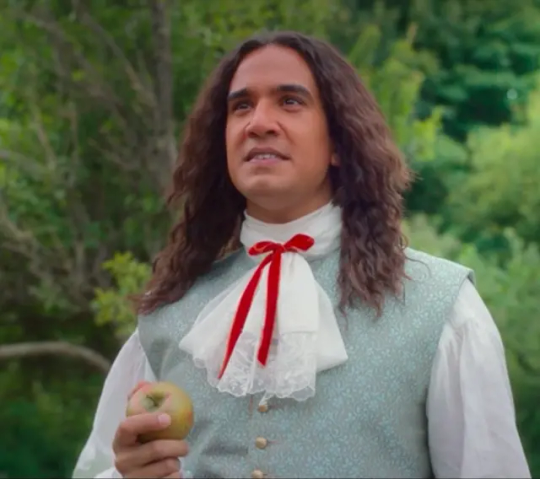
I've also seen him wrongly described as a white actor doing yellow face as Fu Manchu. Not that such portrayals were ever forgivable of course. But another example of the fact that people are quite ignorant of racially mixed actors having had a presence in the history of media. Just look up the name Acquanetta as another example. See image below.

Just a few short words I wanted to get off my chest on the matter. (-;
#my post#gothic#horror#boris karloff#representation#dr jekyll and mr hyde#mycroft holmes#classic hollywood#classic horror#reresentation matters#acquanetta#Rupert Laight#isaac newton#doctor who#biracial#feel free to reblog
40 notes
·
View notes
Text
Hands
@bravosierra6 I finally finished the first chapter
Bode Donovan/Leone x OFC Arizona Telford
Summary: After Bode left Edgewater, he thought that was his rock bottom. He moved away, started going by a different name and started working construction. One day he ended up getting hurt and landed himself in the emergency room where he met Doctor Arizona Telford. It was a whirlwind romance and they were married after being together for eight months. Then Bode relapsed. He ended up disappearing, robbing a store, and going to prison. Arizona was surprised to see her husband in the newspaper for robbing a liquor store. She tried to see her husband in prison but Bode never put her on his visitor list. Arizona learns that her husband is at the CalFire con camp in Edgewater and decides to go see him. Will Arizona have it in her to fight against naysayers, Bode’s family, a new love interest for her husband, and against Bode himself to prove that she’s in this thing forever?
A/N: AZ is pronounced like Mazie, except without the “M”
Face claim: Camilla Luddington for Arizona; Lauren German for Lilith, Christian Kane for Dean
TW: cannon danger, violence, mentions of gun violence and death
Arizona huffed out a nervous breath as she walked towards the inmates scattered around the Three Rock CalFire con camp where her husband was housed. It had been three and a half years since she’d seen her husband, Bode Donovan. Arizona remembered the day she saw his picture in the newspaper for robbing that liquor store. She went to every court date and tried to support Bode the best she could with him doing everything in his power to push her away. It broke her heart when he refused to let her visit him in jail and then in prison. She’d thought about divorce. Her sister, Lilith, and her brother, Dean, suggested it any time Bode’s name came up in a conversation. But Arizona needed to talk to him first. She needed him to know that she still loved him just as much now as she did on their wedding day.
“Can I help you?” A voice pulled Arizona back to the present.
“I’m looking for Bode Donovan.” She smiled at the man with blue eyes and a fu manchu.
“You’re not on his visitors list.” The man responded. Arizona gave him a questioning look. “I’m Captain Manny Perez. I know every one of my guy’s visitors. You’ve never been here before and there’s not a name on Bode’s list that I don’t know personally.”
“Captain Perez,” Arizona started, wringing her hands together, “I really need to speak to Bode. I haven’t seen him in three years. It’s important.”
“Who’s my dad talking to?” Gabriella asked Bode.
“Whoever she is, she’s beautiful.” Sharon said.
Bode’s breath left his body and all the blood drained from his face when he saw who Manny was talking to.
“Bode, are you okay?” Vince asked him.
“Y-yeah,” Bode nodded numbly. “Give me a minute.” He didn’t give anybody a chance to respond as he walked towards Manny and his wife.
“Arizona?” Bode asked, not quite sure he believed what he was seeing.
“Bode,” Arizona gave him a small smile.
“What are you doing here?” He asked, the words coming out harsher than he intended.
“I should be asking you that question,” she shot back. “It’s good to see you’re not dead.”
Bode closed his eyes and took a calming breath. He never imagined seeing his wife at Three Rock. In fact, he never imagined seeing her again. His eyes traveled to where she was twisting her wedding band she still wore.
Arizona’s hands were Bode’s favorite part of her body. Sure, his wife was gorgeous with a great body but her hands were his safe place. He was honest with Arizona from the beginning about his past. He told her about the accident that caused Riley’s death and how Vince blamed him. He explained that his dad told him to leave Edgewater and never return. Any time they talked about the hard stuff, Arizona’s hands were there to calm him. She’d stroke his arm, play with his hair or his beard, rub his back, twist their fingers together. Those soft caresses calmed the noise in his head and started healing the hole in his heart.
When Bode relapsed, he was ashamed of himself. He knew he didn’t deserve a woman like Arizona. He didn’t deserve love. So, he did what Bode Leone did best: he left. He robbed a liquor store and found himself doing three to five years in prison. On those long nights in prison, he’d think about her hands. How they made him feel alive, wanted, cherished, loved. He thought about writing to Arizona so many times but he just couldn’t think of what to say. How do you apologize to the love of your life for letting them down so badly?
“Bode, who is this?” Manny asked.
“This is Arizona.” Bode said, his eyes never leaving her fingers.
“I can’t authorize a visit. She’s not on your list.” Manny sighed.
“Manny…” Bode trailed off, not sure what to say. “She’s…she’s…”
“She’s his wife.” Arizona finished for him. “I know it’s been a long time, Bode. But I’m still your wife.”
“I’ll give you two a minute.” Manny clapped a hand on Bode’s shoulder before walking off.
“How did you find me?” Bode asked her.
Tears pooled in Arizona’s eyes. “After all this time and that’s what you want to know?”
“I never wanted you to see me like this, AZ.” Bode could never imagine how much it hurt to see his wife like this.
“You never wanted me to see you, period.” Arizona sniffled. “You shut me out completely. I would have been there, Bode. I would have been with you through it all.”
“I don’t deserve that.” Bode answered simply.
“And I don’t deserve to have my husband abandon me without so much as a letter telling me it’s over.” Arizona glared at him.
“I…” Bode looked up at the gray, California sky, trying to find the words to convey what he wanted to say. “I never wanted to hurt you, Arizona. I fucked up. I ended up in prison. I waited for divorce papers from you every day for months.”
“Well, if you would have let me see you, I would have told you that I wasn’t going anywhere.” Arizona crossed her arms over her chest.
“It’s been too long.” Bode said. “We can’t go back to what we had before.”
“I didn’t come here to have some big reunion, Bo.” She tucked her hair behind her ears. “I came because…” She swallowed thickly. Arizona shifted from foot to foot not wanting to say what she had to say. She knew it would devastate him.
“Because why?” Bode said quietly. “What happened, Arizona?”
Arizona’s eyes met Bode’s. “Jesse…”
“What about him?” Bode asked, fear running through his body. Jesse Tulane was Arizona’s best friend. He was also a cop in the small town where Bode and Arizona had lived before Bode fucked it all up. Bode and Jesse became really close through their mutual relationships with Arizona. Jesse had been the closest thing to a brother Bode had had since he left Edgewater.
“We lost him, Bode.” Arizona whispered, tears streaming down her face.
“What do you mean we lost him?” Bode demanded. “Isn’t there people out looking for him? He’s a smart guy, Arizona. He’ll find his way home. He’s been lost before! He’s taken me out hiking plenty of times. He knows how to get out.”
“Bode!” Arizona said in a commanding voice to stop his words, her hands resting on his biceps. “He’s dead.”
“No,” Bode’s brain refused to accept her words. There was no way Jesse was dead. He’d kept in contact with Jesse throughout his incarceration. “I just talked to him! You’re wrong, Arizona!”
Arizona broke down sobbing. “I want to be, Bode. I really want to be. He’s gone. He’s gone and I just…I want him back.”
Bode hugged her against him tightly. Tears streamed down his face as she sobbed in his arms. After a few minutes, he led her to a picnic table near where he’d been visiting with Gabriella, Sharon, and Vince. He sat across from her and took her hand in his. “What happened?”
“He was serving a warrant on that sketchy house on the corner of 4th Street. Somebody pulled a gun. Jesse got shot in the neck.” Arizona explained. “We did everything we could but there was too much damage. I pronounced him dead at 3:43 this morning.”
“You pronounced him?” Bode asked, wiping the tears from his face.
Arizona gave him a small smile. “I knew the team wasn’t going to stop with me in the room. They know how close Jesse and I are. They know how much he means to me. I also knew that there was no getting him back.”
“I’m so sorry, Arizona.” Bode whispered.
“Me too,” Arizona squeezed his hand. “He told me just yesterday that he was looking forward to you getting out so he could take you fishing in a new spot he found.”
Bode gave her a lopsided smile. “I’m surprised he even still wanted to talk to me.”
“He said there was no way he was giving up on the only guy who could outfish him.” Arizona chuckled lightly.
“What now?” Bode asked.
Arizona shrugged her shoulders. “I haven’t really thought about it. I took a shower after I got home and came straight here to tell you.”
“How did you know where to find me?”
“Dean called in a favor.” Arizona answered.
“I’m surprised he was willing to do that.” Bode shook his head.
“You know Dean. Anything for his youngest sister.”
Bode nodded. “This doesn’t seem real. I feel like I’m about to wake up back in prison.”
“It’s a lot to take in.”
“How long are you staying in town for?” Bode asked.
“I got a room at the hotel in town. I’m going to get some sleep then I have to head back. There’s a lot to do. I have to pack up Jesse’s things, find a new place to live. I can’t stay in that place. There’s just too many memories. You, me, and Jesse had some great times in that place.”
“We did,” Bode smiled. “He always said he was going to marry the manager of the bar that our apartment was above.”
“He never even got her number.” Arizona laughed.
“Of course,” Bode chuckled. “He talked a big game.”
“Yeah he did.” Arizona nodded.
It was quiet between the pair for a long beat. “I don’t want to leave you.” Arizona whispered.
“I don’t want you to leave.” Bode admitted.
“How about you finally put me on your visitor list?” Arizona suggested. “That way I can come back.”
“I’d like that.” Bode said.
Arizona cupped his face in her hand. “It’s good to see you, Bode. I’ve missed you.”
“I missed you too.” He admitted.
Arizona dropped her hand from his face, gave him a small wave, and walked back towards her car.
“Who was that?” Vince asked once Bode had rejoined them.
“An old friend.” Bode answered.
18 notes
·
View notes
Text
The real question is, since Shen didn't grow any facial hair or anything as he aged, is Feng gonna get his Fu Manchu back?
I mean, obviously he is, it's an iconic part of his design, but like what does that say about Shen?
Eternal baby face boy
#undead unluck#fouryearsandananime#uu spoilers#feng kowloon#shen xiang#i love going from writing lengthy and beautiful prose to 'baby face boy'
14 notes
·
View notes
Text
On December 1, 1967 The Face of Fu Manchu debuted in Japan.

#the face of fu manchu#don sharp#christopher lee#crime thriller#horror thriller#fu manchu#1960s horror#1960s#60s movies#adventure thriller#movie art#art#drawing#movie history#pop art#modern art#pop surrealism#cult movies#portrait#cult film#british horror
5 notes
·
View notes
Note
I agree with the fact that the older Ren pic is weird for the stereotypical mustache, but for the eye, in my perspective of an Asian, I think it’s just like when anime characters smiling, you know, the ^v^ face. Otherwise, I don’t agree with Gato in general plus the n*zi Strade art 💀💀 I usually don’t like bring up past actions but only when said person has changed but Gato still did not change a bit. It’s funny how when someone talked about lizard people a mod quickly came to said it was anti semistic (and it was real though) but when Melon said anti black things she did not say shit
Yea tbh the Ren art COULD be interpreted as that�� but I dunno lol.
Giving Ren a Fu Manchu is so… SJSKSKS it’s a CHOICE that’s for sure
And yea, she’s just… she’s done too many racist things in the past for her to have “changed” plus she’s never spoken up on the Ren art 🤷
I believe people can change, but she’s done it SO many times. It’s crazy. It’s excusable if it’s once and she apologized and fixed it, but she’s done shit like this time and time again. It’s just so sus…
Edit: also, when she made a post apologizing for her excusing mod’s racist behavior… it was a paragraph, and she didn’t even apologize. She was just like “yeah I fucked up” and the rest of the post was her apologizing for deleting the Patreon server 💀
22 notes
·
View notes
Text

Walter Rilla-Karin Dor "El regreso de Fu-Manchu" (The face of Fu Manchu) 1965, de Don Sharp.
8 notes
·
View notes
Text
HALLOWEEN-A-THON 2024
New viewings with an asterisk. 1. Dead of Night (1977)* 2. Halloween: The Curse of Michael Myers (theatrical version) 3. An American Werewolf in London (theatrically) 4. The Wolf Man (1941) 5. The Curse of Frankenstein 6. A Nightmare on Elm Street 4: The Dream Master 7. The Legend of Hell House 8. A Nightmare on Elm Street 5: The Dream Child 9. Son of Frankenstein 10. Snowbeast (1977) 11. Inferno (1980) 12. The Beyond 13. The Terror (1963) 14. Phantasm: RaVager (The For Rory Edition) 15. Halloween: Resurrection 16. Abbott & Costello Meet Frankenstein 17. Fright Night (1985) 18. Friday the 13th (1980) 19. Friday the 13th, Part 2 20. Hellraiser (1987) 21. Poltergeist (1982) 22. The Haunting (1963) 23. Spirits of the Dead 24. The House That Dripped Blood 25. The Predator 26. Silver Bullet 27. The Face of Fu Manchu 28. Halloween 5: The Revenge of Michael Myers 29. Phantasm: OblIVion 30. Sleepaway Camp 31. Wes Craven's New Nightmare 32. Witch Hunt* 33. Evil Eye* 34. Ninja Dragon Sword Legend OVA* 35. Halloween Kills (The This Is How Halloween Ends Edition) 36. White Zombie 37. Hello Mary Lou: Prom Night II 38. The Reptile 39. The Plague of the Zombies 40. The Wicker Man (1973) 41. The Lair of the White Worm 42. The Shining (1980) 43. The Gorgon 44. Dracula's Daughter 45. Dracula, Prisoner of Frankenstein* 46. The Monster Squad 47. Halloween (2018; The Back in Shape Edition) 48. Son of Dracula 49. Amityville: The Awakening* 50. Gremlins 2: The New Batch 51. Hellraiser: Inferno* 52. Mr. Sardonicus 53. Dracula, Prince of Darkness 54. Creepshow (104-minute TV edition) 55. Halloween 4: The Return of Michael Myers 56. Halloween III: Season of the Witch 57. Prince of Darkness (theatrical version) 58. Prince of Darkness (TV Version) 59. The Abominable Snowman of the Himalayas 60. Fangs of the Living Dead 61. They Live 62. Jason Lives: Friday the 13th, Part VI 63. Late Night with the Devil* 64. Bram Stoker's Count Dracula (1970) 65. Dracula Has Risen from the Grave 66. The Werewolf vs. the Vampire Woman 67. Goke, Body Snatcher from Hell 68. The City of the Dead 69. House of Frankenstein (1944) 70. The Masque of the Red Death (1964) 71. Black Sunday (1960) 72. The Devil Rides Out 73. The Keep 74. Beetlejuice 75. Hellraiser: Hellseeker 76. Trap* 77. Friday the 13th, Part V: A New Beginning (TV Version) 78. Phantasm 79. Freddy vs. Jason 80. Halloween II (1981; TV Version) 81. Horror of Dracula (uncut version) 82. The Seventh Victim 83. Halloween 6: The Curse of Michael Myers (Producer's Cut) 84. The Mummy (1959) 85. Bride of Frankenstein 86. Taste the Blood of Dracula 87. Halloween (1978) 88. Halloween II (1981; theatrical version) 89. Frankenstein Meets the Wolf Man
3 notes
·
View notes
Text
my face has a similar problem area to toki's face (big ol obnoxious round chin) and so one of the things i can say metalocalypse has brought to my life is the unfortunate awareness that i'd look much better with a fu manchu moustache
11 notes
·
View notes
Text
in 2023 I watched some movies
I was gonna catch up on all those best picture nominees from the last 5 years, but watched crap like Caligula 2 instead
The 1989 World Tour - Live (2015, dir. Jonas Åkerlund) Glass Onion: A Knives Out Mystery (2022, dir. Rian Johnson) Flight 666 (2008, dir. Scot McFayden and Sam Dunn) Dracula (1931, dir. Todd Browning) Moonraker (1979, dir. Lewis Gilbert) The Pez Outlaw (2022, dir. Bryan Storkel and Amy Bandlien Storkel) Encino Man (1992, dir. Les Mayfield) Star Trek: Insurrection (1998, dir. Jonathan Frakes) Once Upon a Time in… Hollywood (2019, dir. Quentin Tarantino) Cleopatra (1963, dir. Joseph L. Mankiewicz) The Alligator People (1959, dir. Roy Del Ruth) The Silence of the Lambs (1991, dir. Thomas Demme) Godzilla vs. Megalon (“ゴジラ対メガロ” 1973, dir. Jun Fukuda) Invasion of Astro-Monster (“怪獣大戦争” 1965, dir. Ishirō Honda) Breaking a Monster (2015, dir. Luke Meyer) Terror at Orgy Castle (1971, dir. Zoltan G. Spencer) Wake in Fright ("Outback" 1971, dir. Ted Kotcheff) m.A.A.d. (2014, dir. Khalil Joseph) Reservoir Dogs (1992, dir. Quentin Tarantino) Kung Pow! Enter the Fist (2002, dir. Steve Oedekerk) House (1977, dir. Nobuhiko Obayashi) Raiders of the Lost Ark (1981, dir. Steven Spielberg) Dunkirk (2017, dir. Christopher Nolan) Final Destination (2000, dir. James Wong) Glitch: The Rise & Fall of HQ Trivia (2023, dir. Salima Koroma) Basic Instinct (1992, dir. Paul Verhoeven) Pee Wee’s Big Adventure (1985, dir. Tim Burton) Caligula 2: The Untold Story (“Caligola: La storia mai raccontata” 1982, dir. Joe D’Amato) La noche del terror ciego (1972, dir. Amando de Ossorio) Rocky IV (1985, dir. Sylvester Stallone) Saw IV (2007, dir. Darren Lynn Bousman) House of Wax (1953, dir. Andre DeToth) Thir13en Ghosts (2001, dir. Steve Beck) Kashchey the Immortal (“Кащей Бессмертный” 1944, dir. Aleksandr Rou) Ghost Ship (2002, dir. Steve Beck) The Blood on Satan’s Claw (1971, dir. Piers Haggard) The Face of Fu Manchu (1965, dir. Don Sharp) The Brides of Fu Manchu (1966, dir. Don Sharp) The Vengeance of Fu Manchu (1967, dir. Jeremy Summers) The Blood of Fu Manchu (1968, dir. Jesús Franco) April Fool's Day (1986, dir. Fred Walton) It's Pat 1994, dir. Adam Bernstein) The Castle of Fu Manchu (1969, dir. Jesús Franco) Adam and Eve Meet the Cannibals ("Adam ed Eve, la prima storia d'amore" 1983, dir. Enzo Doria & Luigi Rosso) The Mountain of the Cannibal God (“La montagna del dio cannibale” 1978, dir. Sergio Martino) When Harry Met Sally… (1989, dir. Rob Reiner) Beetlejuice (1988, dir. Tim Burton) Lord of the Rings: Fellowship of the Ring (2001, dir. Peter Jackson, Long as Shit Version) The Hobbit (1977, dir. Arthur Rankin Jr. & Jules Bass) The Cabinet of Dr. Caligari (1920, dir. Robert Wiene) The Wicker Man (1973, dir. Robin Hardy) The Texas Chain Saw Massacre (1974, dir. Tobe Hooper) House of 1000 Corpses (2003, dir. Rob Zombie) Chopping Mall (1986, dir. Jim Wynorski) Basket Case (1982, dir. Frank Henenlotter) Cube (1997, dir. Vincenzo Natali) Cube 2: Hypercube (2002, dir. Andrzej Sekula) Practical Magic (1998, dir. Griffin Dunne) Tropic Thunder (2008, dir. Ben Stiller) Star Wars: The Force Awakens (2015, dir. J.J. Abrams) Star Wars: The Last Jedi (2017, dir. Rian Johnson) Star Wars: The Rise of Skywalker (2019, dir. J.J. Abrams) Eyes Wide Shut (1999, dir. Stanley Kubrick) Superbad (2007, dir. Greg Mottola) Bruce Almighty (2003, dir. Tom Shadyac) House of Flying Daggers (“十面埋伏” 2004, dir. Zhang Yimou) Saltburn (2023, dir. Emerald Fennell) Grandma’s Boy (2006, dir. Nicholaus Goossen) Five Nights at Freddy's (2023, dir. Emma Tammi) Caligula and Messalina (“Caligula et Messaline” 1981, dir. Bruno Mattei) The Wizard of Oz (1939, dir. Victor Fleming, King Vidor, George Cukor, and Norman Taurog) A Christmas Prince (2017, dir. Alex Zamm) A Christmas Prince: The Royal Wedding (2018, dir. John Schulz) The Knight Before Christmas (2019, dir. Monika Mitchell) Goldfinger (1964, dir. Guy Hamilton) Total Recall (1990, dir. Paul Verhoeven)
13 notes
·
View notes
Text
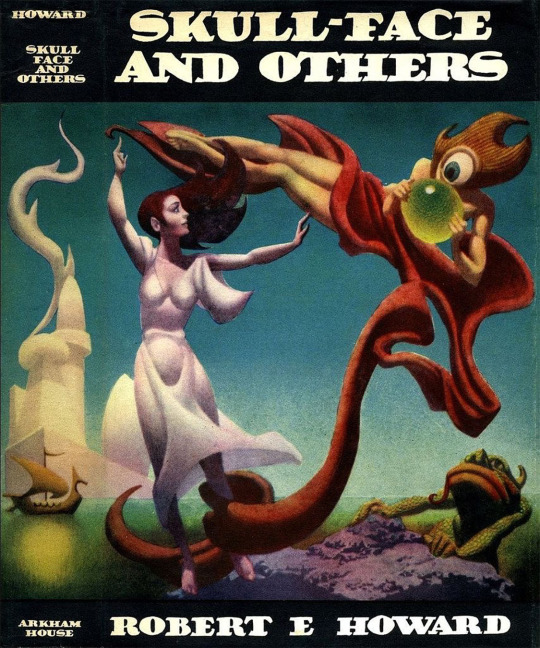
SKULL-FACE AND OTHERS by Robert E. Howard (Sauk City: Arkham House,1946) Cover by Hannes Bok.
Fantasy/horror collection. Limited to 3004 copies.
Skull-Face is a fantasy novella originally serialized in Weird Tales (October through December, 1929). Clearly influenced by Sax Rohmer's opus Fu Manchu it substitutes a resuscitated Atlantean necromancer for the Asian villain. From the center of a web of crime and deceit he means to end Western world domination in order to re-instate surviving Atlanteans (lying dormant in submerged sarcophagi) as the new ruling elite.

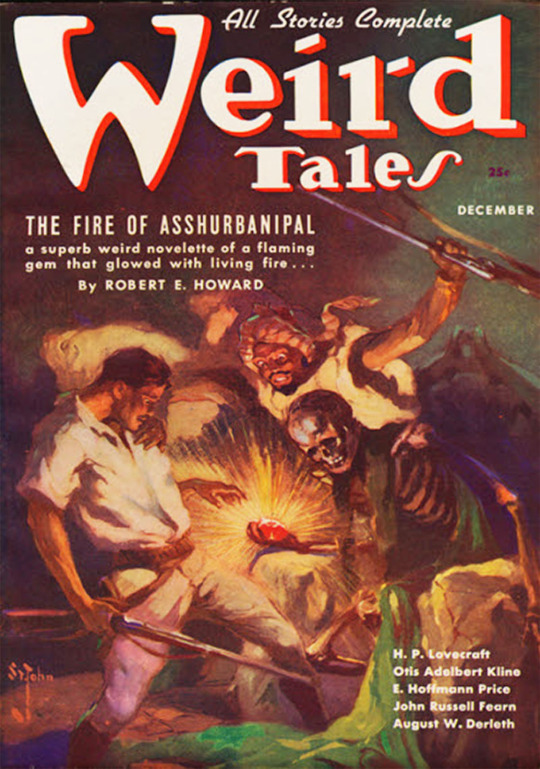
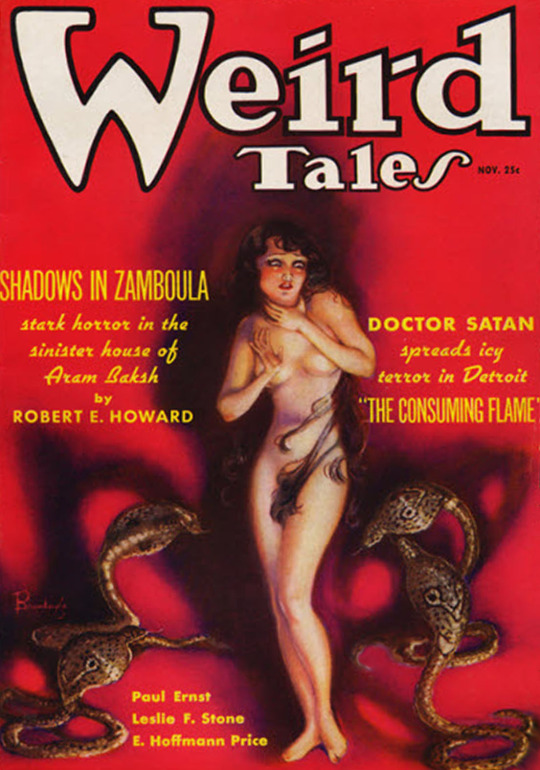
Wolfshead (Weird Tales, April 1926) Cover by F.M. Stevenson • The Fire of Asshurbanipal (Weird Tales, December 1936) Cover by J. Allen St. John • Shadows in Zamboula (Weird Tales, November 1935) Cover by Margaret Brundage.
Contents:
vii · Foreword · August Derleth
ix · Which Will Scarcely Be Understood (Weird Tales, October 1937)
xiii · Robert E. Howard: A Memoriam by H.P. Lovecraft (Fantasy Magazine, September 1936), as “In Memoriam: Robert E. Howard”; revised from “Robert Ervin Howard: 1906-1936” (The Phantagraph, August 1936)
xvii · A Memory of R.E. Howard by E. Hoffmann Price [A slightly different version appeared in The Ghost, May 1945 as “The Book of the Dead, Chapter 2, Robert Ervin Howard”.]
Wolfshead (Weird Tales, April 1926) [de Montour]
The Black Stone (Weird Tales, November 1931) [Cthulhu]
“The Horror from the Mound” (Weird Tales, May 1932)
The Cairn on the Headland (Strange Tales of Mystery and Terror, January 1933)
Black Canaan (Weird Tales, June 1936)
The Fire of Asshurbanipal (Weird Tales, December 1936) [Cthulhu]
“A Man-Eating Jeopard” (Cowboy Stories, June 1936) [Buckner Grimes]
The Hyborian Age (LANY Cooperative Publications, 1938) [The first half was published in The Phantagraph, (February, August, & October/November 1936)]
Skull-Face (Weird Tales, October 1929) [Kathulos]
Worms of the Earth (Weird Tales, November 1932) [Bran Mak Morn]
The Valley of the Worm (Weird Tales, February 1934) [James Allison]
“Skulls in the Stars” (Weird Tales, January 1929) [Solomon Kane]
“Rattle of Bones” (Weird Tales, June 1929) [Solomon Kane]
The Hills of the Dead (Weird Tales, August 1930) [Solomon Kane]
Wings in the Night (Weird Tales, July 1932) [Solomon Kane]
The Shadow Kingdom (Weird Tales, August 1929) [Kull]
“The Mirrors of Tuzun Thune” (Weird Tales, September 1929) [Kull]
Kings of the Night (Weird Tales, November 1930) [Bran Mak Morn; Kull]
The Phoenix on the Sword (Weird Tales, December 1932) [Conan]
The Scarlet Citadel (Weird Tales, January 1933) [Conan]
The Tower of the Elephant (Weird Tales, March 1933) [Conan]
Rogues in the House (Weird Tales, January 1934) [Conan]
Shadows in Zamboula (Weird Tales, November 1935) [Conan]
Lines Written in the Realization That I Must Die (Weird Tales, August 1938)
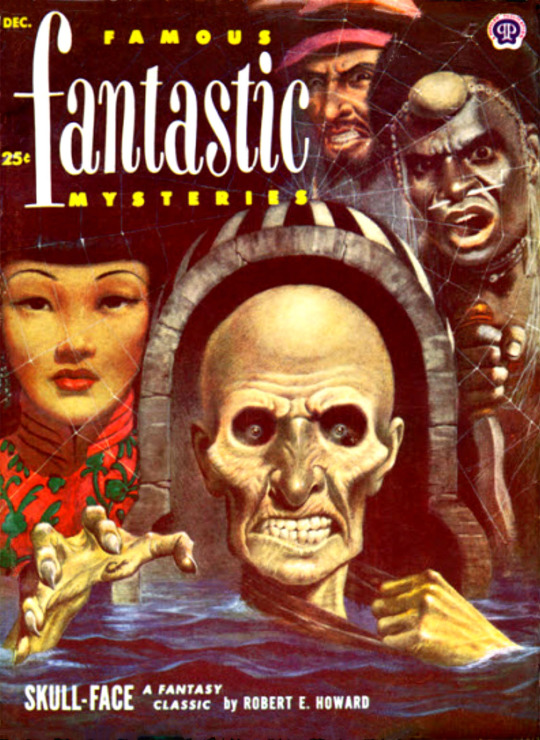
Famous Fantastic Mysteries (December, 1952) Cover by Lawrence. [reprint magazine]
Skull-Face by Robert E. Howard [Weird Tales, October 1929]
Killdozer! by Theodore Sturgeon [Astounding Science Fiction, November 1944]
“The Homecoming” by Ray Bradbury [Mademoiselle, October 1946]
“The Coat” by A.E.D. Smith [from POWERS OF DARKNESS edited by Philip Allan, 1934]
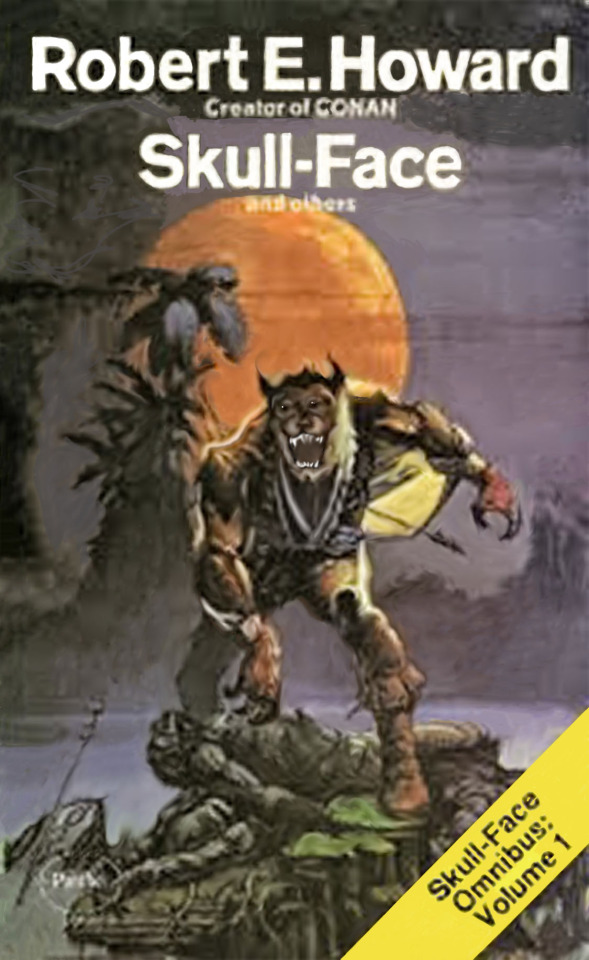


(London: Panther, 1976) Cover by Chris Achilleos. • (New York: Berkley, 1978) • (Japan)
#book blog#books#books books books#book cover#pulp art#pulp fantasy#horror#beautiful books#skull-face#robert e. howard#hannes bok#margaret brundage#j allen st john#book design#cthulhu#conan#bran mak morn#weird tales#science fiction#solomon kane#arkham horror#dark fantasy#sword and sorcery#cthulhu mythos#chris achilleos#famous fantastic mysteries
10 notes
·
View notes